Personal Experience – the user interface
Posted: March 23, 2015 By: Edo-Jan Meijer
At Unit4 we approach software development as if our applications are the user’s colleagues. We consider the users’ needs very carefully and how we can create a simple but great experience for them. We always ask ourselves in the software design process: ‘what is the personal (latent) need of a specific user’, ‘how can we, as their software colleague, answer their questions in the same way human interaction takes place’ and ‘how do we communicate our answers to the end-user so he/she understands without further explaining’.
We start a UX design process by asking ourselves if we need to confront the user with an interface anyway. The best solutions are presented before a question has been asked or a need has arisen. By combining separate data in our software in a smart way, we can make predictions. For example, a manager or consultant may have travel preferences and obvious patterns they adhere to on business trips. Through location data our software knows where they travel often, where they like to stay and eat. It knows how they get there and therefore how they would get back. We’re moving towards self-driving enterprise applications. When that data is presented, in a pre-populated expense claim for example, the user only needs to ‘Approve’, ‘Decline’ or ‘Adjust’ when prompted for the information. No more unnecessary extensive grids, complex workflows, and time consuming data entry. And the best bit is that the experience will be different for every user, tailored to their needs based on the personal context, use of device, individual needs, and user-defined and existing data.
Where a user interface is necessary, users only see relevant information. Isn’t that refreshing? The user only has to enter applicable data. Data or functionality that isn’t relevant for the user is deleted, moved or hidden from the screen. Depending on the personal needs of the user of course. We design our interfaces to be simple and useable, always asking ourselves ‘is this a response we would give if asked a question by a colleague, person to person?’
To ensure a reliable and natural experience, we connect our software as seamlessly as possible to the personal world of the user. Our visual design is modern, simple, and elegant. The lay-out of every page is understandable, easy to use, and intuitive. The interaction flows naturally because it runs at the pace of human behavior. And we let the end-user ‘feel’ our software by adding transitions and other kinds of motion so the user understands what to do without even noticing the software guides.
All combined, our software makes the user feel empowered unlike enterprise software of the past. It helps them to do their jobs better and gives them a feeling of being treated with politeness and respect. They will even feel the software understands them for it provided the right answers at the right time and helped them to be successful. In the end, our users always have a great day at the office.


